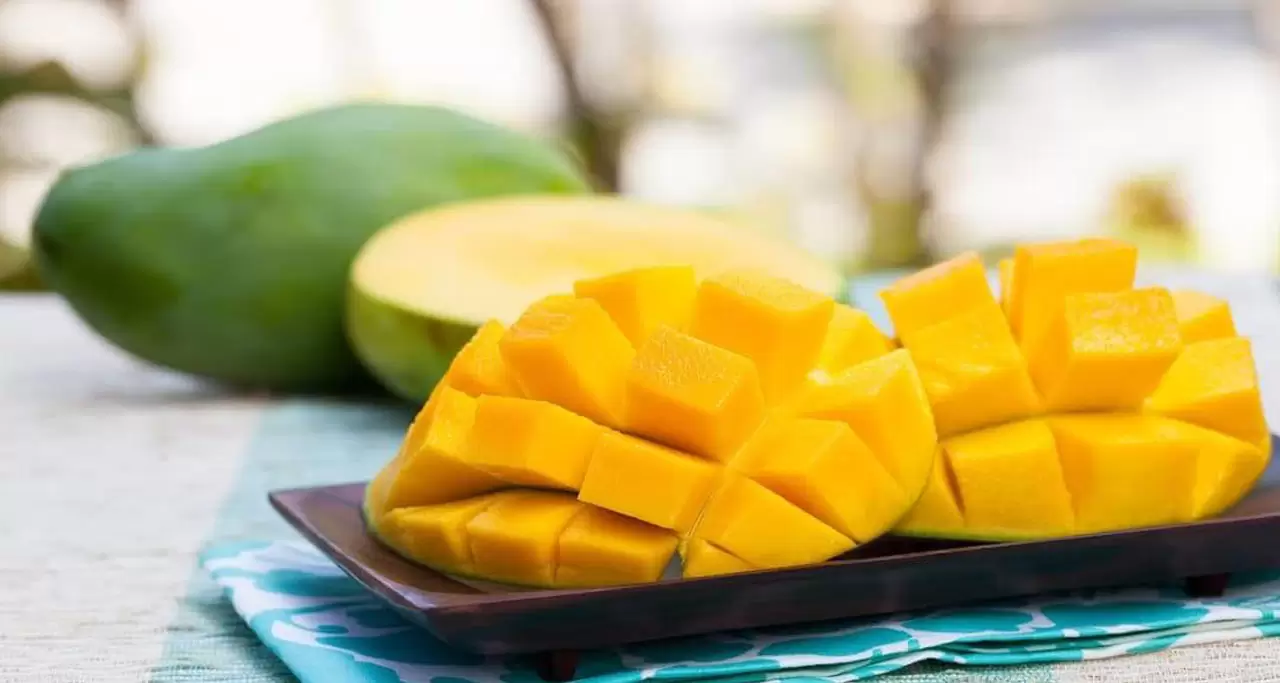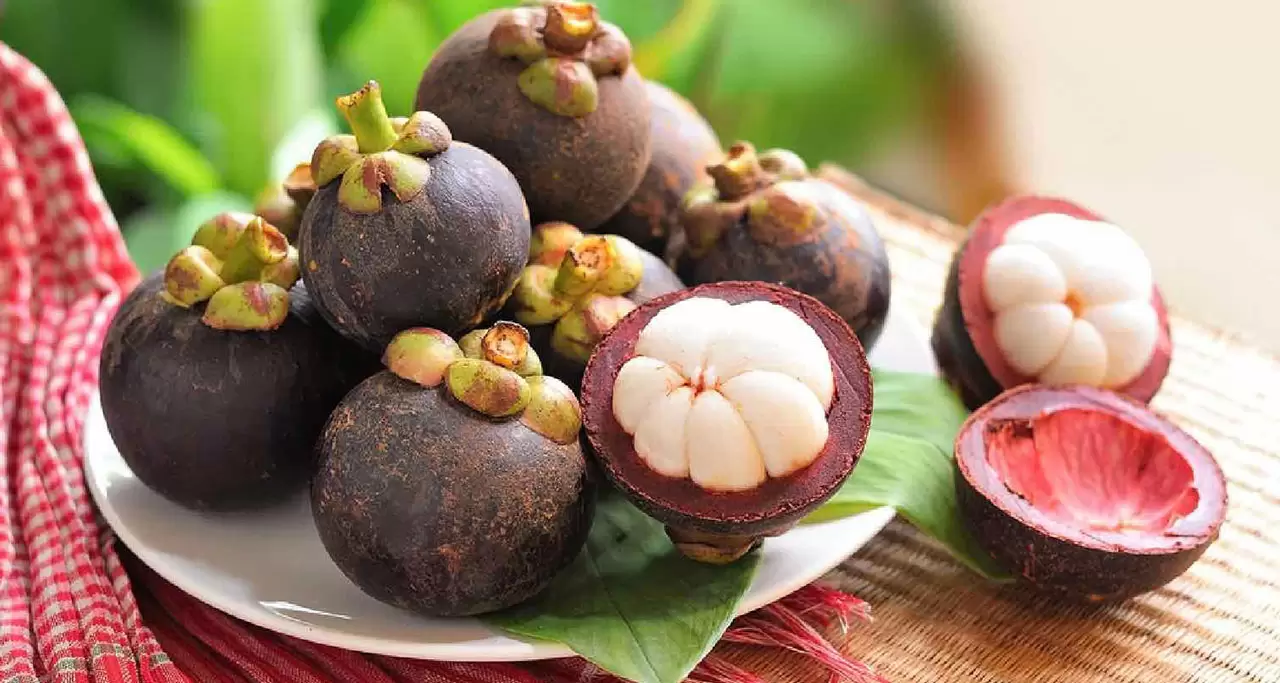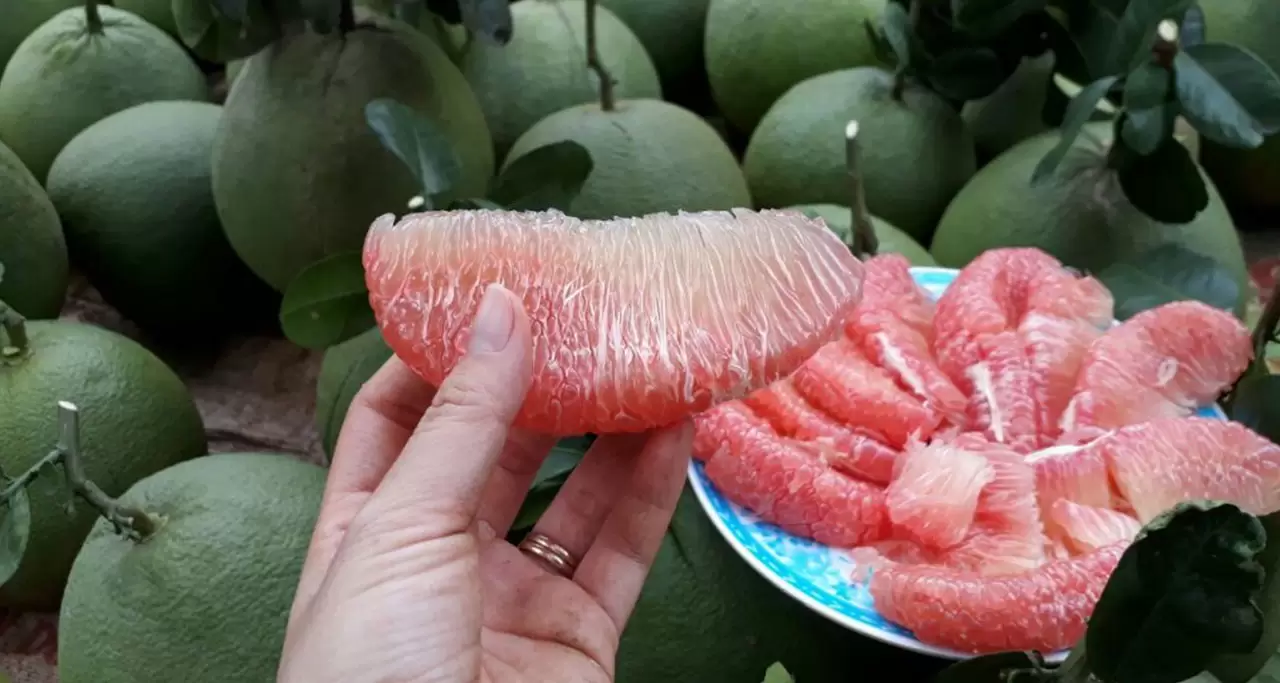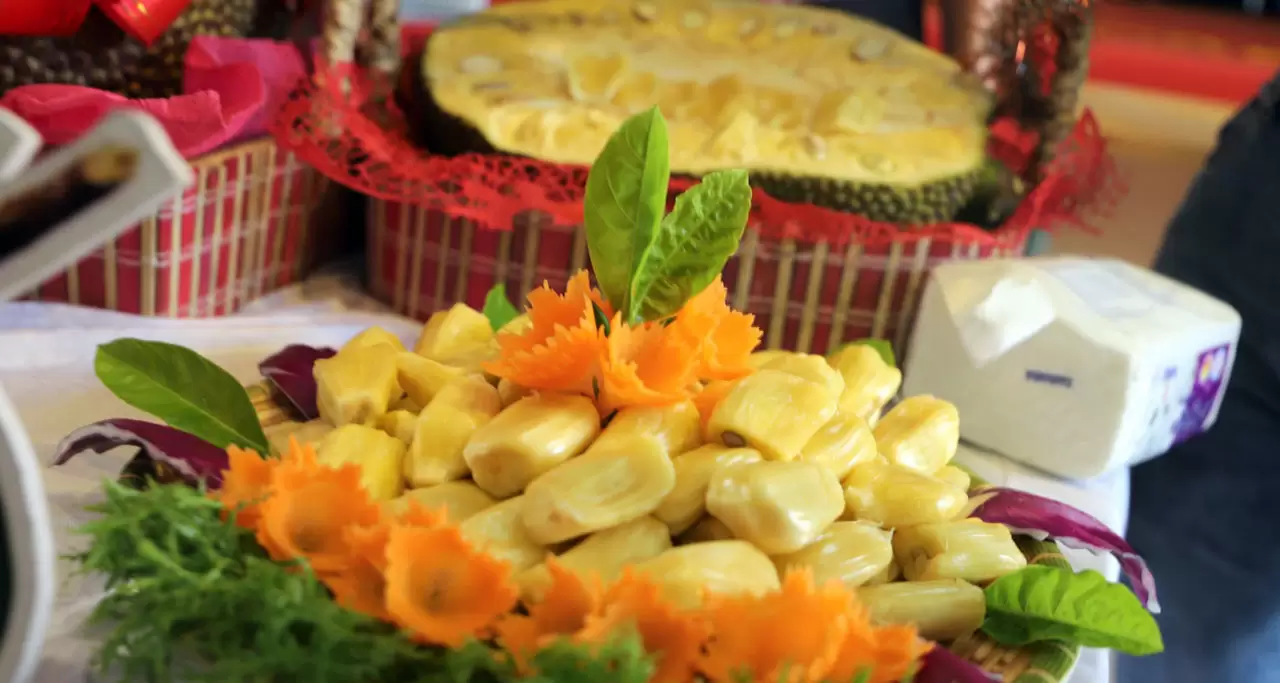Being geographically located in the tropical zone, Vietnam is truly a heaven when it comes to fruits. One who first comes to the country will be amazed at the countless number of colorful fruits sold at a very reasonable price in every street and market all year round. Trying & tasting different exotic fruits are one of the factors that attract travelers time and time again. These are some following fruits that are worth a try when traveling to Vietnam.
Top Tropical Fruits in Vietnam
1. Mango (Xoài)

Mangoes are grown mostly in southern Vietnam’s provinces such as Tien Giang, Dong Thap, Can Tho, and some northern regions like Moc Chau, Son La, Ha Giang, Lai Chau. There are several kinds of mangoes in Vietnam: the yellow ones with sweet and soft meat including “xoai cat”, “xoai tuong”, “xoai ngua”; and the green sour ones “xoai xanh”. With a large variety of mangoes available, they are abundant from February to May in the South & May & September in the North.
Aromatic and juicy, the Vietnamese love eating ripe fresh mango or making smoothie while green mangoes as snack dipped in chili salt and shredded in a savoury green mango salad (gỏi xoài).
2. Mangosteen (Măng cụt)

This fruit is a real tropical resident, and it loves the heat. The best place to find măng cụt in Vietnam is in the Mekong Delta. Its season often lasts from May to September. Mangosteen contains special nutrients that can purify your body and relieve stress, which is the reason Mangosteens are also known as the ‘nemesis’ of durian – a fruit that can produce a lot of heat in your body.
Using a sharp knife to peel off the rough upper part, you will see the white pulp arranged in equal segments. The meat of the fruit is heavenly delicious, soft sour and sweet, creating the light and pure refreshment.
3. Rambutan (Chôm Chôm)

The best fruit comes from the provinces of the Mekong Delta, even though you can easily spot rambutan at any market around Vietnam. Like many of the other tropical fruits, rambutans also provide a multitude of health benefits such as skin care, hair care, cancer prevention, and a boost in energy.
A fun way of saying ‘messy hair’, rambutan are as delicious as they are colourful. Their vibrant and hairy exterior hides white translucent flesh with a mild sweet and sour flavour, similar to a grape. Give the fruit a slight pinch and twist to remove the exterior and reveal the flesh, then enjoy!
4. Longan (Long Nhãn)

Longan is a favourite fruit in Vietnam, which is usually harvested in July & August, and famous in some provinces & cities such as Hung Yen, Hue, Vung Tau, Vinh Long, Tien Giang, and Can Tho, but they are easily spotted in big bushels throughout the country’s many street markets.
The name long nhãn has an interesting meaning, which is “dragon eye” because when you peel off the skin, the round black seeds and white flesh look like small eyes. There are many ways to eat longan, such as longan sweet soup and lotus seed, longan ice-cream topped with peanut, herbal juice with longan, raw or as dried fruits. This is one of the sweet tropical fruits to try!
5. Lychee (Vải thiều)

Like many other fruits, lychee is also comprised of many vital nutrients that help prevent heart disease, increase digestion, and it’s even a natural painkiller. The most delicious lychee can be found in Bac Giang and Hai Duong, particularly in the beginning of the summer.
Its skin is dark red and easy to peel by hand. The juicy white center has a lot of vitamin C and natural sweetness. It can be served raw or making a cool beverage such as lychee tea and lychee cocktails.
6. Dragon fruit (Thanh Long)

A direct translation for its name, dragon fruit is grown widely in the Mekong Delta. Dragon fruit has a bizarre look, with thick fuschia rind and wispy green extensions outside. Inside, the flesh is white or purple dotted with small seeds.
The fruits are rich in vitamin C, B1, B2, and B3, and contain minerals such as iron, calcium, and phosphorus. All those nutrients are the reason dragon fruit can protect you from heart problems, aging skin, and acne.
To enjoy dragon fruit, you need to cut the fruit vertically into two halves. Continue to cut the two pieces to get smaller portions which you can comfortably hold in your hand. Gradually remove the peel as you eat each piece or just remove it all at once and enjoy. It tastes succulent, with a slightly sour note, but a little sweet at the same time.
7. Guava (Ổi)

Guava is famous in many parts of the world. Brought into Asia from Central America, guavas in Vietnam are green with white or pink flesh, and have a light, herbal flavour. In Vietnam, you can enjoy guava as refreshing juice or raw by simply cutting them into small long pieces and serving them with salt. Many people in Vietnam eat skin and the seed of guava as well. The white peach center has a slight fragrance and sour-sweetness that goes well with the salty taste.
8. Pomelo (Bưởi)

Pomelos can be found at most of the year in Vietnam, and on display during special occasions.
Like as grapefruit’s giant cousin, but with a milder taste, pomelos are worth the effort while they might appear intimidating. This large, slightly oblong citrus is green and faintly yellow when ripe.
Once you cut the pomelo open, you’ll see the thick white pith obstructing its pale yellow or pink flesh. Where pomelo stands out is once you peel off the bitter tasting pith, the flesh is made up of curious little sacs filled with juice. Pomelo is a popular ingredient in Vietnamese savoury salads, such as gỏi bưởi.
9. Star Apple (Vú Sữa)

Grown in orchards in the Mekong Delta and Central Vietnam, the Vietnamese name for star apple translates to mothers’ milk, and is connected to an old folktale. This spherical fruit is roughly the size of an orange, with tight, shiny skin in shades of violet or green. The skin and rind are bitter, but the fruit inside is white with a mellow taste.
Not only does it taste good, star apple also contains a lot of nutrition like dietary fiber, vitamins, minerals, acid amin, and more. It helps prevent many health problems, even colon cancer. There are two ways to try star apples like a local. You can cut it in half and scoop out the fruit with a spoon, or you can press and roll it to release the juice inside, then puncture a hole in the bottom to suck out the milky juice.
10. Watermelon (Dưa Hấu)

Known as a juicy fruit in the tropical areas, watermelon is one of favourite choices as fresh yummy smoothie for your thirsty in summer. In Vietnam, there are seedless and yellow watermelons.
During Tet holiday, you can also find a pair of watermelon on the alter in the Vietnamese family.
11. Custard Apple (Na or Mãng Cầu)

Custard apple, called Na or Mãng Cầu by the Southern people, is one of the most unique fruits in the country.
July will be the time to hunt down the best custard apples. The bumpy green skin covers the white flesh and hard black pips. The taste is sweet and floral, promising a unique and satisfying mouthfeel. The riper they become, the more their shells expands, and this particular action is called “opening eyes.” As a delicious fruit, this is good source of Vitamin B and C.
There are two types of custard apple in Vietnam, na dai and na bở. Most people prefer na dai because it tastes sweeter and has fewer seeds.
12. Sapodilla (Hồng Xiêm)

This fruit is grown mostly in northern Vietnam, with the shape of an egg and brownish skin. When ripe, the brown and yellow pulp is very juicy and has a molasses-like taste. Available all year round, you can find this fruit at local markets and the place that has the best one is Xuan Dinh, Tu Liem District, Hanoi.
13. Jackfruit (Mít)

Jackfruit is one of the most popular fruits in Vietnam. The most famous jack-fruit is called mít tố nữ. Although its shape is smaller than other types of jack-fruit in Vietnam, it tastes sweeter and smells better.
This fruit contains a massive amount of vitamin C as well as nutrients that help prevent cancer and aging of internal organs. It also helps protect your digestive tract, your eyes, your bones, and your skin.
There are lot of fleshy yellow knots covering all the seeds of the fruit when peeled. However, its latex is sticky so remember to use a towel or glove to separate the outer of the fruit and take the knots out.
14. Durian (Sầu Riêng)

Known as “stinky fruit”, durian has a remarkable characteristic of tasting like heaven but smelling like hell. In some countries, it’s forbidden to carry durian on public transport or take them into a hotel.
A durian consists of several segments separated into different compartments. The fruit’s large seeds are encased by the edible, eye-catching, bright yellow flesh. If you are a fruit-aholic, you will enjoy this unusual fruit a lot because nothing compares to its incredible, creamy, sweet flavor.
With over more than 60 kinds of sầu riêng from different regions in Vietnam, the king of all is sầu riêng Cai Mon from Ben Tre province.
15. Coconut (Dừa)

Among all the fruits, coconut is probably the most popular and has the most uses. In Southern Vietnam, coconut can be found in Ben Tre, a province which has been famous for this kind of fruits for many years.
Coconut juice is a popular drink in the hot summer. Its flesh can be enjoyed raw, with sweet chè, or in stewed recipes; and its oil is aromatic enough for spa treatment.
The coconut juice, besides being served as a refreshment, can be used in many Vietnamese dishes, especially to give the broth or sauted sauce a natural sweet flavour. Desserts made from either coconut juice or flesh are always popular as well.
Coconut can be easily found in the market or on the streets, especially in summer time. Imagine having a sip of the fresh coconut juice and relax yourself on one of the best beaches in the world: welcome to Vietnam!
The diversity of tropical fruits is an exciting experience which you should not miss when visiting the South East countries like Vietnam. Along with friendly locals, historical sites, and rich culture, these fruits in Vietnam can be another remarkable memory in your journey!




